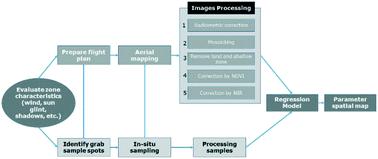当前位置:
X-MOL 学术
›
Environ. Sci.: Water Res. Technol.
›
论文详情
Our official English website, www.x-mol.net, welcomes your
feedback! (Note: you will need to create a separate account there.)
Monitoring cyanobacterial harmful algal blooms by unmanned aerial vehicles in aquatic ecosystems
Environmental Science: Water Research & Technology ( IF 3.5 ) Pub Date : 2021-1-12 , DOI: 10.1039/d0ew00830c Alejo Silvarrey Barruffa 1, 2 , Álvaro Pardo 2 , Robert Faggian 1 , Victor Sposito 1
Environmental Science: Water Research & Technology ( IF 3.5 ) Pub Date : 2021-1-12 , DOI: 10.1039/d0ew00830c Alejo Silvarrey Barruffa 1, 2 , Álvaro Pardo 2 , Robert Faggian 1 , Victor Sposito 1
Affiliation

|
The spatial distribution of harmful algal blooms may change rapidly due to variations in wind, water current, and population dynamics. Traditional sampling methods may not be enough for an effective local risk assessment. Unmanned aerial vehicles can gather data at appropriate spatial and temporal resolutions, with full control over data collection timing and rapid result availability. We show that data can be correlated with chlorophyll (r2 = 0.79) and cyanobacteria (r2 = 0.77) concentration at the water surface, leading to spatial distribution maps capable of spotting cyanobacteria patches in water bodies precisely. In addition, climatic change may benefit various species of harmful cyanobacteria by increasing their geographic distributions and modifying population dynamics. Thus, new methods with a high spatial and temporal resolution for monitoring blooms come handy under changing climate scenarios. The method presented here provides valuable information that is complementary to risk assessment data derived from other monitoring methods available.
中文翻译:

通过无人飞行器监测水生生态系统中的蓝藻有害藻华
由于风,水流和种群动态的变化,有害藻华的空间分布可能会迅速变化。传统的抽样方法可能不足以进行有效的本地风险评估。无人机可以在适当的时空分辨率下收集数据,并完全控制数据收集的时间和快速的结果可用性。我们表明数据可以与叶绿素(r 2 = 0.79)和蓝细菌(r 2= 0.77)在水表面的浓度,导致能够准确地在水体中发现蓝细菌斑块的空间分布图。此外,气候变化可通过增加其地理分布和改变种群动态来使各种有害蓝藻受益。因此,在气候变化的情况下,具有高时空分辨率的用于监测水华的新方法非常有用。此处介绍的方法提供了有价值的信息,这些信息是对从其他可用监视方法得出的风险评估数据的补充。
更新日期:2021-01-28
中文翻译:

通过无人飞行器监测水生生态系统中的蓝藻有害藻华
由于风,水流和种群动态的变化,有害藻华的空间分布可能会迅速变化。传统的抽样方法可能不足以进行有效的本地风险评估。无人机可以在适当的时空分辨率下收集数据,并完全控制数据收集的时间和快速的结果可用性。我们表明数据可以与叶绿素(r 2 = 0.79)和蓝细菌(r 2= 0.77)在水表面的浓度,导致能够准确地在水体中发现蓝细菌斑块的空间分布图。此外,气候变化可通过增加其地理分布和改变种群动态来使各种有害蓝藻受益。因此,在气候变化的情况下,具有高时空分辨率的用于监测水华的新方法非常有用。此处介绍的方法提供了有价值的信息,这些信息是对从其他可用监视方法得出的风险评估数据的补充。











































 京公网安备 11010802027423号
京公网安备 11010802027423号